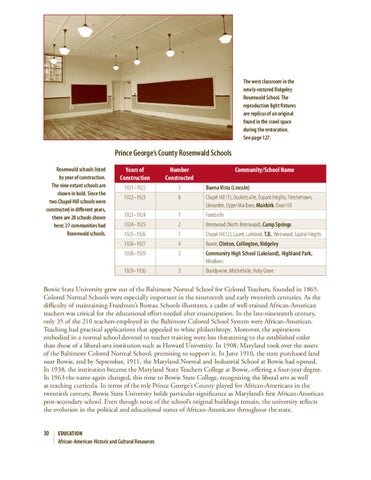The west classroom in the newly-restored Ridgeley Rosenwald School. The reproduction light fixtures are replicas of an original found in the crawl space during the restoration. See page 127.
Prince George’s County Rosenwald Schools Rosenwald schools listed by year of construction. The nine extant schools are shown in bold. Since the two Chapel Hill schools were constructed in different years, there are 28 schools shown here; 27 communities had Rosenwald schools.
Years of Construction
Number Constructed
Community/School Name
1921–1922
1
Buena Vista (Lincoln)
1922–1923
8
Chapel Hill (1), Duckettsville, Dupont Heights, Fletchertown, Glenarden, Upper Marlboro, Muirkirk, Oxon Hill
1923–1924
1
Forestville
1924–1925
2
Brentwood (North Brentwood), Camp Springs
1925–1926
7
Chapel Hill (2), Laurel, Lakeland, T.B., Westwood, Capitol Heights
1926–1927
4
Bowie, Clinton, Collington, Ridgeley
1928–1929
3
Community High School (Lakeland), Highland Park, Meadows
1929–1930
3
Brandywine, Mitchellville, Holly Grove
Bowie State University grew out of the Baltimore Normal School for Colored Teachers, founded in 1865. Colored Normal Schools were especially important in the nineteenth and early twentieth centuries. As the difficulty of maintaining Freedmen’s Bureau Schools illustrates, a cadre of well-trained African-American teachers was critical for the educational effort needed after emancipation. In the late-nineteenth century, only 35 of the 210 teachers employed in the Baltimore Colored School System were African-American. Teaching had practical applications that appealed to white philanthropy. Moreover, the aspirations embodied in a normal school devoted to teacher training were less threatening to the established order than those of a liberal-arts institution such as Howard University. In 1908, Maryland took over the assets of the Baltimore Colored Normal School, promising to support it. In June 1910, the state purchased land near Bowie, and by September, 1911, the Maryland Normal and Industrial School at Bowie had opened. In 1938, the institution became the Maryland State Teachers College at Bowie, offering a four-year degree. In 1963 the name again changed, this time to Bowie State College, recognizing the liberal arts as well as teaching curricula. In terms of the role Prince George’s County played for African-Americans in the twentieth century, Bowie State University holds particular significance as Maryland’s first African-American post-secondary school. Even though none of the school’s original buildings remain, the university reflects the evolution in the political and educational status of African-Americans throughout the state.
30
EDUCATION African-American Historic and Cultural Resources
